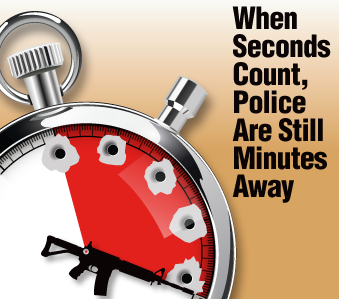Why The Bombs Didn’t Explode
The mass shooting by two students at Columbine High School in 1999 was a game changer in terms of law enforcement response. But according to the Jefferson County Sheriff’s report on the incident, it could have been much, much worse.
At Columbine, two youths aged 17 and 18, planned to use propane bombs on timers to kill as many students as possible while they were having lunch in the school cafeteria. They planned to shoot students fleeing the explosions, according to the sheriff’s report. The high school is near Littleton, a suburb of Denver, but the Jefferson County Sheriff’s Office has law enforcement jurisdiction.
On April 20, 1999, the two youths drove to the school in their cars and parked them near the entrances to the cafeteria. Sometime about 11:14 a.m., they got out of their cars and toted two 20-pound propane bombs in duffle bags into the cafeteria and placed them near two lunch tables. They return to their cars to wait for the explosion.
The bombs were set to explode at 11:17 but they didn’t go off. The students got out of their cars and a couple of minutes later the shooting started.
The 18-year-old carried a sawed-off pump-action 12-guage shotgun and a Hi-Point 9mm carbine. The 17-year-old carried a TEC-DC-9, 9mm semi-automatic pistol that looked like a small submachinegun. He also carried a cut-down Stevens 12-gauge double-barreled shotgun.
At 11:19, the killers were seen on a vantage point at the top of a flight of steps near the west entrance to the school. One of them was heard yelling: “Go, go.” Both pulled their shotguns from duffle bags they were carrying and the killing began.
Rachel Scott and another student were eating lunch on the grass outside the west entrance to the school when the two gunmen opened fire. Scott was the first student killed; her companion was wounded. After shooting several other students, one of the killers exchanged fire at 60 yards with the school resource officer, a Jefferson County deputy sheriff. Both missed.
The two killers entered the school building and stormed into the library. According to the report, there were fifty-six people inside the library. In seven and a half minutes – between 11:29 and 11:36 – the gunmen murdered ten and wounded twelve. The last victim was killed at 11:35. The killers left the library and wandered randomly around the second floor shooting into empty rooms. They went down into the cafeteria and finally returned to the library where they killed themselves.
Throughout their rampage, the two killers set off pipe bombs and other explosives that they carried in backpacks and duffle bags. Thirty bombs of the seventy-six that were found at the school did explode.
Despite the explosions and sound of gunshots inside the building, the officers remained outside the school and were ordered to hold their perimeter while the killing continued. More officers arrived on the scene and organized a shuttle to protect the students fleeing the building. Initially they provided them with cover behind their patrol cars.
Jefferson County SWAT team commander Lieut. Terry Manwaring assembled an ad hoc SWAT team consisting of a dozen officers from Jefferson County, Denver, and Littleton. Manwaring split them into two groups with the first group entering the school at 12:06 p.m., forty-seven minutes after the active killers fired their first shots.
According to the sheriff’s report, the killers committed suicide between 12:05 and 12:08. In the sixteen minutes of their killing spree, the two gunmen murdered 12 students and one teacher. They wounded 21 others with three more injured while escaping.
Until Columbine the standard response by law enforcement to mass shootings had been for the first officers to arrive to set up a perimeter around the building or scene and wait for the SWAT team. It was the shooting at Columbine that demonstrated the inadequacy of SWAT teams to deal with active killers.
“Columbine was a true tactical error because we didn’t understand the problem. Law enforcement did not understand the problem,” said John Benner, a former SWAT team commander and owner of Tactical Defense Institute, a shooting school near Cincinnati. “But Columbine was the thing that really changed law enforcement because we realized we can’t sit out here. We’ve got to go in.”
Benner said they went to the tactical experts and asked their advice. The result was to train small teams of regular officers to go in. The first officer on the scene would wait until he was joined by three or four officers and they would enter the building together.
“We still didn’t fully understand the problem. I am including myself in this.”
The small team approach was better than waiting for the SWAT team but it still didn’t work. It took too long.
“You can’t wait. It takes time, is the problem and that’s the thing we didn’t understand. Unfortunately, we’ve got enough numbers now that we understand the problem better. So Columbine changed from a tactical team response to a multi-officer response, which was still a mistake,” Benner said.
The protocol at many law-enforcement organizations now is that the first officer on the scene goes in immediately and seeks out the killer or killers.
But why didn’t the 20-pound propane tank bombs in the cafeteria explode?
The two youths set the bombs to go off at 11:17 a.m. They had calculated that this was when the maximum number of students would have been in the cafeteria. Had they detonated, the sheriff’s report estimated that most of the 488 people in the cafeteria would have been killed or seriously injured.
The sheriff’s report stated: “Because of faulty wiring and poorly constructed devices, the twenty-pound propane bombs did not detonate.”
But that is only part of the story. Several reliable and credible sources told me the reason the propane bombs did not go off had to do with the clocks that were used as timers. The two killers bought one of the clocks to test and it worked to set off a test device. They later bought more of the same make and model of clock which they attached to the bombs they left in the cafeteria. But between the time they bought the first clock and the second batch, the manufacturer changed the hands from metal to plastic which did not complete the electrical circuit necessary to set off the bombs.
Imagine for a moment that the propane bombs had exploded, killing and wounding more than 400 high-school students. The political chaos would be massive. We would have to have licenses to buy propane; propane tank size limited to five pounds; background checks; waiting periods to buy alarm clocks; all clocks required to have plastic hands . . .
The material for this article came from the author’s latest book, Surviving a Mass Killer Rampage: When Seconds Count, Police Are Still Minutes Away.




